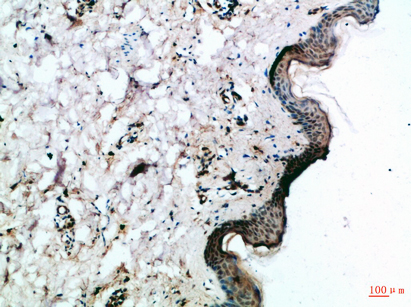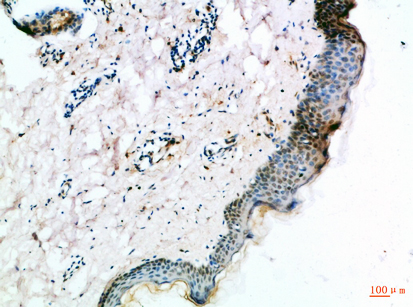Frizzled-4 Polyclonal Antibody
- Catalog No.:YT6042
- Applications:IHC;IF;ELISA
- Reactivity:Human;Mouse;Rat
- Target:
- Frizzled-4
- Fields:
- >>mTOR signaling pathway;>>Wnt signaling pathway;>>Hippo signaling pathway;>>Signaling pathways regulating pluripotency of stem cells;>>Melanogenesis;>>Cushing syndrome;>>Alzheimer disease;>>Pathways of neurodegeneration - multiple diseases;>>Human papillomavirus infection;>>Pathways in cancer;>>Proteoglycans in cancer;>>Basal cell carcinoma;>>Breast cancer;>>Hepatocellular carcinoma;>>Gastric cancer
- Gene Name:
- FZD4
- Protein Name:
- Frizzled-4 (Fz-4) (hFz4) (FzE4) (CD antigen CD344)
- Human Gene Id:
- 8322
- Human Swiss Prot No:
- Q9ULV1
- Mouse Gene Id:
- 14366
- Mouse Swiss Prot No:
- Q61088
- Immunogen:
- Synthetic peptide from human protein at AA range: 11-60
- Specificity:
- The antibody detects endogenous Frizzled-4
- Formulation:
- Liquid in PBS containing 50% glycerol, 0.5% BSA and 0.02% sodium azide.
- Source:
- Polyclonal, Rabbit,IgG
- Dilution:
- IHC 1:50-200, ELISA 1:10000-20000. IF 1:50-200
- Purification:
- The antibody was affinity-purified from rabbit antiserum by affinity-chromatography using epitope-specific immunogen.
- Concentration:
- 1 mg/ml
- Storage Stability:
- -15°C to -25°C/1 year(Do not lower than -25°C)
- Other Name:
- Frizzled-4 (Fz-4;hFz4;FzE4;CD antigen CD344)
- Background:
- frizzled class receptor 4(FZD4) Homo sapiens This gene is a member of the frizzled gene family. Members of this family encode seven-transmembrane domain proteins that are receptors for the Wingless type MMTV integration site family of signaling proteins. Most frizzled receptors are coupled to the beta-catenin canonical signaling pathway. This protein may play a role as a positive regulator of the Wingless type MMTV integration site signaling pathway. A transcript variant retaining intronic sequence and encoding a shorter isoform has been described, however, its expression is not supported by other experimental evidence. [provided by RefSeq, Jul 2008],
- Function:
- disease:Defects in FZD4 are the cause of vitreoretinopathy exudative type 1 (EVR1) [MIM:133780]; also known as autosomal dominant familial exudative vitreoretinopathy (FEVR) or Criswick-Schepens syndrome. EVR1 is a disorder of the retinal vasculature characterized by an abrupt cessation of growth of peripheral capillaries, leading to an avascular peripheral retina. This may lead to compensatory retinal neovascularization, which is thought to be induced by hypoxia from the initial avascular insult. New vessels are prone to leakage and rupture causing exudates and bleeding, followed by scarring, retinal detachment and blindness. Clinical features can be highly variable, even within the same family. Patients with mild forms of the disease are asymptomatic, and their only disease-related abnormality is an arc of avascular retina in the extreme temporal periphery.,domain:Lys-Thr-X-X-X-Trp mot
- Subcellular Location:
- Cell membrane ; Multi-pass membrane protein .
- Expression:
- Almost ubiquitous (PubMed:10544037). Largely expressed in adult heart, skeletal muscle, ovary, and fetal kidney (PubMed:10544037). Moderate amounts in adult liver, kidney, pancreas, spleen, and fetal lung, and small amounts in placenta, adult lung, prostate, testis, colon, fetal brain and liver (PubMed:10544037).
- June 19-2018
- WESTERN IMMUNOBLOTTING PROTOCOL
- June 19-2018
- IMMUNOHISTOCHEMISTRY-PARAFFIN PROTOCOL
- June 19-2018
- IMMUNOFLUORESCENCE PROTOCOL
- September 08-2020
- FLOW-CYTOMEYRT-PROTOCOL
- May 20-2022
- Cell-Based ELISA│解您多样本WB检测之困扰
- July 13-2018
- CELL-BASED-ELISA-PROTOCOL-FOR-ACETYL-PROTEIN
- July 13-2018
- CELL-BASED-ELISA-PROTOCOL-FOR-PHOSPHO-PROTEIN
- July 13-2018
- Antibody-FAQs
- Products Images

- Immunohistochemical analysis of paraffin-embedded Human-skin, antibody was diluted at 1:100

- Immunohistochemical analysis of paraffin-embedded Human-skin, antibody was diluted at 1:100



